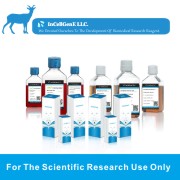

| Organism | Homo sapiens, human |
|---|---|
| Tissue | colon; derived from metastatic site: ascites |
| Product Format | frozen |
| Morphology | epithelial |
| Culture Properties | mixed, adherent and suspension |
| Biosafety Level |
1
Biosafety classification is based on U.S. Public Health Service Guidelines, it is the responsibility of the customer to ensure that their facilities comply with biosafety regulations for their own country. |
| Disease | Dukes'' type D, colorectal adenocarcinoma |
| Age | 70 years |
| Gender | male |
| Ethnicity | Caucasian |
| Applications |
This cell line is a suitable transfection host.
|
| Storage Conditions | liquid nitrogen vapor phase |
| Karyotype | The stemline chromosome number is hypertriploid and 10-11 marker chromosomes (M1, M2, M4, M5, M6 and 5 others) were common in monosomic, disomic and trisomic condition although most of these markers were monosomic. |
|---|---|
| Derivation |
This line was isolated in 1975 by T.U. Semple, et al. from ascitic fluid of a 70-year-old Caucasian male with carcinoma of the colon. The patient had been treated with 5-fluorouracil for 4-6 weeks before removal of the fluid specimen.
|
| Clinical Data |
70 years Caucasian male The patient had been treated with 5-fluorouracil for 4-6 weeks before removal of the fluid specimen. |
| Genes Expressed |
carcinoembryonic antigen (CEA) 1.5 to 4.1 ng/10 exp6 cells/10 days; keratin; interleukin 10 (IL-10, interleukin-10),The cells are positive for keratin by immunoperoxidase staining.
|
| Cellular Products |
carcinoembryonic antigen (CEA) 1.5 to 4.1 ng/10 exp6 cells/10 days; keratin; interleukin 10 (IL-10, interleukin-10)
|
| Tumorigenic | Yes |
| Effects |
Yes, in nude mice
(Tumors developed within 21 days at 100% frequency (5/5) in nude mice inoculated subcutaneously with 10(7) cells)
|
| Comments |
The line was derived from tissue from the same patient as COLO 201 (ATCC CCL-224). The cells are CSAp negative (CSAp-).
The cells are positive for keratin by immunoperoxidase staining.
COLO 205 cells express a 36000 dalton cell surface glycoprotein related to the GA733-2 tumor associated antigen.
|
| Complete Growth Medium |
The base medium for this cell line is ATCC-formulated RPMI-1640 Medium, ATCC 30-2001. To make the complete growth medium, add the following components to the base medium: fetal bovine serum (ATCC 30-2020) to a final concentration of 10%. |
|---|---|
| Subculturing |
Cells grow loosely attached and in suspension. Shake flask, retain the floating cells by transfering them into a centrifuge tube. Cells that remain attached may be removed using a standard trypsinization protocol (see below) and combined with the retained floating cells. Volumes used in this protocol are for 75 cm2 flask; proportionally reduce or increase amount of dissociation medium for culture vessels of other sizes.
Subcultivation Ratio: A subcultivation ratio of 1:2 to 1:6 is recommended
Medium Renewal: Every 2 to 3 days
|
| Cryopreservation |
Freeze medium: Complete culture medium, 95%; DMSO, 5%
Storage temperature: liquid nitrogen vapor phase
|
| Culture Conditions |
Temperature: 37��C
|


